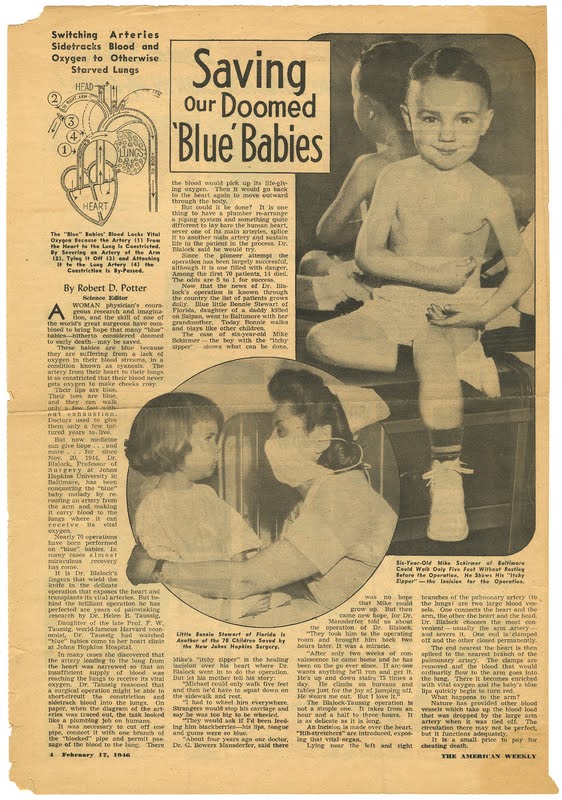- De Luca C. Something the Lord Made: ovvero il blu si tramutò in rosa. 14 aprile 2019. http://www.storiadellamedicina.net
- The blue baby operation. The Alan Mason Chesney Medical Archives of the Johns Hopkins Medical Institutions. https://medicalarchives.jhmi.edu:8443/page1.htm
Medical History: The blue baby
The first "blue baby" surgery, known as the Blalock-Taussig shunt, was a groundbreaking medical procedure performed in 1944 to treat children suffering from congenital heart defects.
Tetralogy of Fallot
The combination of a VSD (Ventricular Septal Defect) with Pulmonary Stenosis, with the Aorta "Overriding" (sitting 'astride') the VSD and with RV Hypertrophy is termed "Tetralogy of Fallot". Tetralogy of Fallot is the most common form of cyanogenic congenital heart disease, with an incidence close to 10% of all forms of congenital heart disease.
The obstruction to flow into the lungs leads to blood being diverted through the VSD to the aorta. Flow in the lung circulation is reduced and the child appears 'Blue' (cyanosed). Some affected patients, who are severely blue, need a temporary operation (called a shunt operation), which is carried out in infancy to increase lung blood flow and improve cyanosis. This involves insertion of a tiny piece of artificial tube (made from Goretex) between the Aorta, or a branch (usually one of the arm arteries), and one of the branch Pulmonary Arteries.
Corrective surgery is usually performed at about six months. Correction involves closure of the VSD with a patch and enlargement of the narrow area of the right ventricle and pulmonary artery (pulmonary stenosis), often requiring a further patch. (complete repair).
"We watched the baby turn from blue to pink.”
In 1944, Dr. Blalock and Dr. Taussig decided to proceed with anastomosis between the subclavian artery and the pulmonary artery in a little girl suffering from tetralogy of Fallot.
At that time, Alfred Blalock was chief of surgery at the Johns Hopkins Hospital, as well as professor and head of the department of surgery at the medical school. Blalock was assisted by surgical research technician Vivien Thomas. Their collaboration lasted over 30 years. Thomas, who had no academic qualifications, was known for his great intelligence and superb surgical skills.
One day, while Blalock was discussing his progress on coarctation, cardiologist Helen Taussig introduced him to the problem of “blue baby syndrome”, speculating that an arterial shunt could supply more blood to the lungs and, therefore, to the whole body. “If you could put the carotid artery into the descending aorta, couldn't you put the subclavian artery into the pulmonary artery?” he said. Dr Helen Taussig was convinced that the operation would help patients.
The little patient who ushered in the modern era of cardiac surgery was Eileen Saxon, “The Blue Baby”. Eileen had blue lips and fingers, while the rest of her skin had a very slight blue tinge. She could only take a few steps before becoming dyspnoic.
On 29 November 1944, Eileen was the first human being to undergo a Blalock-Taussig shunt. She was 15 months old. The operation was performed by Dr Alfred Blalock, with Vivien Thomas behind him to advise him in performing the operation. The surgery had been designed and first performed on laboratory dogs by Thomas, who had then taught the technique to Blalock. Although Thomas had perfected the technique, he could not perform the surgery because he was not a doctor.
Robert D. Potter, “Saving our doomed blue babies,” Exhibits: The Sheridan Libraries and Museums, accessed April 22, 2025, https://exhibits.library.jhu.edu/items/show/1255.
Something the Lord Made
The surgery was not entirely successful, as Eileen Saxon returned to cyanosis a few months later. Another shunt on the opposite side of the chest was attempted, but the little girl, very close to her second birthday, died a few days later. Although Eileen died, she lived long enough to prove that the operation would work and tens of thousands of children could be saved. Blalock's team later discovered that the operation would work better on older children.
In 1945, Blalock and Taussig presented the first three surgical operations in their landmark article “The Surgical Treatment of Malformations of the Heart”, published in the Journal of the American Medical Association. Although their procedure was not a permanent cure, the “blue baby” operation inspired an explosion of surgical innovations that produced lasting treatments for a wide variety of congenital heart diseases.
The story of Dr. Alfred Blalock, a white, well-to-do doctor, chief of surgery, and laboratory technician Vivien Thomas, a black, former carpenter with dreams of becoming a doctor, both protagonists of the medical breakthrough that saved thousands of lives is told in the 2004 film “Something the Lord Made”.
